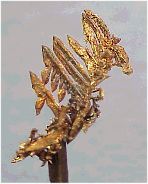The Mineral silver

Silver is one of the most famous precious metals, and has been used for ornamental purposes since the earliest of times. Most silver is extracted from silver ores, but considerable amounts are mined from Native Silver. Silver can be found pure, but is usually mixed with small amounts of gold, arsenic, and antimony. A natural alloy of gold and silver is known as Electrum, and is usually classified as a variety of Gold.
Silver is a very resistant mineral. It does not dissolve in most solvents, and won't react to oxygen or water. However, it has a detrimental reaction to sulfur and sulfides, which causes it to tarnish on exposed surfaces. Hydrogen sulfide (H2S) is found in the atmosphere in small quantities, and when silver is exposed to normal air it reacts to the hydrogen sulfide, causing the tarnish. Egg yolks, which contain sulfur compounds, should be kept away from silver. Several chemical coats are available to protect it from tarnish, and certain polishes remove tarnish.
For additional information, see the gemstone section on Silver.
Color
Silver-white on untarnished surfaces. Tarnishes dark yellow to black.
Properties
Streak
Silver-white to light gray. Streak shiny. |
Hardness
2.5 - 3 |
Transparency
Opaque |
Specific Gravity
9.6 - 12.0 |
Luster
Metallic |
Cleavage
None |
Fracture
Hackly |
Tenacity
Ductile and malleable |
Other ID Marks
1) Tarnish. On a freshly broken surface, the color is bright metallic-white. Upon prolonged exposure, it tarnishes black, brown to gray, and dark yellow.
2) Silver is the best conductor of electricity.
|
Varieties
-
A natural mixture of Copper and Silver. Also the term describing an alloy of copper and silver.
Uses
Silver has many unique physical properties that give it very special status. Silver is the best conductor of electricity, is the second most malleable and ductile metal, and is in greater abundance than all other precious metals with similar properties. Due to its unique properties and intrinsic beauty, it is extensively used industrially and as ornaments.
Silver is largely used as jewelry, ornaments, and coins. It is very easy to work with, and beautiful objects are created from it, such as goblets, candelabras, trays, and cutlery.
In the industrial sector, silver is widely used for electrical apparatuses and circuits. It is also used for medicinal purposes, particularly in dentistry, for bactericides, and for antiseptics.
Noteworthy Localities
Kongsberg, Norway; and Freiberg, Saxony, Germany (especially the Himmelsfürt mine), are perhaps two most classic localities. They once provided beautiful dendritic crystals and wiry masses in abundance, but are now long exhausted. Specimens from these locations are greatly cherished by collectors and extremely hard to obtain, commanding exceedingly high prices.
The finest New World occurrence is Batopilas, Chihuahua, Mexico, where large masses and skeletal agglomerates occur in beautiful form. Famous European localities include Pribram, Bohemia, Czech Republic; Schneeberg and Pöhla in the Erzgebirge, Saxony, Germany; and the Balcoll Mine, Falset, Catalonia, Spain. Australia has famous Silver occurrences at the Elura Mine, Cobar, and at Broken Hill, both in New South Wales. China and Kazakhstan have recently become excellent specimen producers, specifically in Lujiang, Anhui Province, China; and Sarbay and Dzhezkazgan, Kazakhstan.
Another recent producer of fine specimens is the Imiter Mine in the Anti-Atlas Mountains of Morocco. South America has the well-known occurrences of Potosi, Bolivia; Chañarcillo, Copiapó, Chile; and the Uchucchacua Mine, Oyon Province, Peru.
The U.S. lacks good localities of Native Silver, although much has been found in the Creede District, Mineral Co., Colorado, as well as in the Copper mines of Houghton and Keweenaw Counties in the Keweenaw Peninsula in Michigan. The most famous Canadian locality is the Cobalt area, Timiskaming District, Ontario. Other Canadian locations are the El Bonanza Mine, Great Bear Lake, Northwest Territories; and Silver Islet, Thunder Bay, Ontario.
Distingushing Similar Minerals
Platinum - Harder (4 - 4½), does not tarnish, heavier (14 - 19), and usually in different form.
Galena, Acanthite, and Skutterudite - Darker color, darker colored streak, usually in different form.
Molybdenite and Stibnite - Softer (2), different crystal form.
Lead - softer (1.5), oxidizes to a slight bluish-gray color.